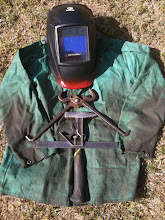Components:
Two conduit connectors, not real sure what they WERE
Two red Jagermeister blinky buttons
A clutch plate from a motorcycle
A blue Ikea Star Lampshade
Two b-line unistrut brackets
A white cat litter bucket lid
Scrap Leather Strap
And a piece of a license plate

There are two bits that slide inside the connector. I used that to sandwich a leather strap across the inside of it to give me a place to hook the Jagermeister blinky tag. After that I screwed them back together to hold the strap in.

Now to make the body. First, I used the clutch plate to make a template on my cat liter bucket lid.
Next I took the clutch plate and welded the connectors to it. You can see the results of this:

Then I riveted the cat litter bucket disk to the back of the clutch plate to give it a white body. Next I took the blue Star and cut two of the points off. Be careful when cutting this, as it is brittle plastic!

So I put a hole in the back side of where the wing was so I could get it to be 3D. But I only used one rivet to attach the wing so that I can move the wings up and down. The one rivet is tight enough to hold the entire wing in place. I cut a strip out of the license plate, bent it into a c-clamp and then used the part with the license sticker to make it into a triangle-shaped red beak.

Then it got riveted to the plastic body too. Finally, I took the brackets, set them on my welding table in what looked good for a final position. Then I held the body over the brackets and tack welded the body to the feet. It melted the plastic a little bit, but not enough to worry about for structure. Instead, it gave it character!
And voila! Disco Blinky Eyed Patriotic Owl. Now if I could only get him to whistle Dixie…. :)

 There are two bits that slide inside the connector. I used that to sandwich a leather strap across the inside of it to give me a place to hook the Jagermeister blinky tag. After that I screwed them back together to hold the strap in.
There are two bits that slide inside the connector. I used that to sandwich a leather strap across the inside of it to give me a place to hook the Jagermeister blinky tag. After that I screwed them back together to hold the strap in.  Then I riveted the cat litter bucket disk to the back of the clutch plate to give it a white body. Next I took the blue Star and cut two of the points off. Be careful when cutting this, as it is brittle plastic!
Then I riveted the cat litter bucket disk to the back of the clutch plate to give it a white body. Next I took the blue Star and cut two of the points off. Be careful when cutting this, as it is brittle plastic!  So I put a hole in the back side of where the wing was so I could get it to be 3D. But I only used one rivet to attach the wing so that I can move the wings up and down. The one rivet is tight enough to hold the entire wing in place. I cut a strip out of the license plate, bent it into a c-clamp and then used the part with the license sticker to make it into a triangle-shaped red beak.
So I put a hole in the back side of where the wing was so I could get it to be 3D. But I only used one rivet to attach the wing so that I can move the wings up and down. The one rivet is tight enough to hold the entire wing in place. I cut a strip out of the license plate, bent it into a c-clamp and then used the part with the license sticker to make it into a triangle-shaped red beak.  Then it got riveted to the plastic body too. Finally, I took the brackets, set them on my welding table in what looked good for a final position. Then I held the body over the brackets and tack welded the body to the feet. It melted the plastic a little bit, but not enough to worry about for structure. Instead, it gave it character!
Then it got riveted to the plastic body too. Finally, I took the brackets, set them on my welding table in what looked good for a final position. Then I held the body over the brackets and tack welded the body to the feet. It melted the plastic a little bit, but not enough to worry about for structure. Instead, it gave it character!








 I couldn’t keep it looking right. I decided to add some more cross braces and clamp down on the attachment points some more. I used a cross brace on the top to help support and give a hanging point. I added four braces in the bottom section to hold the uprights equally apart. Over all I’m happy with how it came out. The best thing however is it actually fits my head.
I couldn’t keep it looking right. I decided to add some more cross braces and clamp down on the attachment points some more. I used a cross brace on the top to help support and give a hanging point. I added four braces in the bottom section to hold the uprights equally apart. Over all I’m happy with how it came out. The best thing however is it actually fits my head.






































